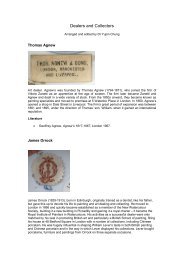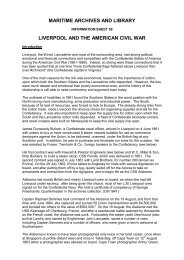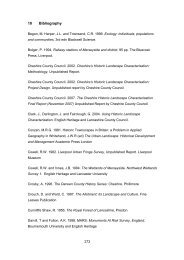Famille Noire porcelain - National Museums Liverpool
Famille Noire porcelain - National Museums Liverpool
Famille Noire porcelain - National Museums Liverpool
You also want an ePaper? Increase the reach of your titles
YUMPU automatically turns print PDFs into web optimized ePapers that Google loves.
William Lever’s collecting of <strong>Famille</strong> <strong>Noire</strong> <strong>porcelain</strong><br />
Konstanze A. Knittler, PhD candidate<br />
Department of History of Art, University of Glasgow<br />
The Lady Lever Art Gallery’s collection is very rich in <strong>Famille</strong> <strong>Noire</strong> <strong>porcelain</strong>s, a<br />
prominent type of Qing dynasty (16441912) <strong>porcelain</strong> that featured significantly in<br />
many British art collections around the turn of the 20 th century. <strong>Famille</strong> <strong>Noire</strong> can be<br />
described as a subgroup of <strong>Famille</strong> Verte, which developed from the wucai palette<br />
(meaning fivecolour) in the late Ming dynasty. The terms were coined by the French<br />
Jesuit and ceramic collector Albert Jacquemart in 1873 and <strong>Famille</strong> <strong>Noire</strong> can<br />
generally be defined as bearing a coppergreen leadbased enamel over an unfired<br />
coating of Chinese cobalt ‘émail sur biscuit’ (on the biscuit). During enamel firing, the<br />
two combined to give an intensely black effect, with a hint of green. The technique<br />
was first used at Jingdezhen in the mid15 th century, but it disappeared again until the<br />
late 17 th century, when it was taken up once more at the court of the emperor Kangxi<br />
(16621722). 1<br />
Owing to this circumstance, <strong>Famille</strong> <strong>Noire</strong> has generally been regarded as having<br />
been produced in the Kangxi era of the Qing dynasty and, in literature around the<br />
turn of the past century, even been mistaken as late Ming (13681644). Many pieces<br />
bear a Chenghua (14651487) reign mark on the base, for which reason many<br />
experts were mislead at the end of the 19 th century into believing that these pieces<br />
originated from the Ming period.<br />
This misconception gave impetus to the author’s further investigating this type of<br />
ware; during a personal examination of <strong>Famille</strong> <strong>Noire</strong> in the Victoria and Albert<br />
Museum’s collection that houses the Salting collection, it could be established that<br />
due to their general appearance most of the pieces inspected were unlikely to date to<br />
the Kangxi period, and that from today’s standards they could even be considered<br />
‘fakes’ of the late 19 th century, in imitation of Kangxi wares. 2 The Lady Lever Art<br />
Gallery, in comparison, includes a considerable amount of similar pieces to the<br />
1<br />
For a technical definition of <strong>Famille</strong> <strong>Noire</strong> compare for example Wood Nigel, Chinese glazes.<br />
Their origins, chemistry and recreation, London/Philadelphia 1998, pp. 235238<br />
2<br />
This handling session was carried out together with an expert on Chinese Ceramics, Gordon<br />
Lang, the Keeper of the Asian Department, Beth Mc Killop, and Dr Luisa Mengoni, Curator, Asian<br />
Department. I am very grateful for their help and support in this research.<br />
1
Salting Bequest and due to that apparent similarity, this essay will look into the<br />
question of collecting <strong>Famille</strong> <strong>Noire</strong> and the authenticity of the ‘black ground’ wares,<br />
as they were also referred to at the time.<br />
Before taking a closer look into the actual <strong>Famille</strong> <strong>Noire</strong> objects from the Lever<br />
collection, and their stylistic analysis, it will be a necessary step to explain why these<br />
wares had become so popular during the late 19 th century and early 20 th centuries<br />
and how scholars and connoisseurs have perceived them in the past 100 years.<br />
<strong>Famille</strong> <strong>Noire</strong> and its discussion in literature<br />
As early as 1881, O. du Sartel presented some <strong>Famille</strong> <strong>Noire</strong> vases within the<br />
section of Ming dynasty <strong>porcelain</strong>s in his publication on Chinese <strong>porcelain</strong>. Although<br />
they bear Chenghua marks, he assessed them to be copies or imitations (of Ming<br />
ware), and he dated them towards the very early years of the Kangxi period. In<br />
addition, he illustrated some more <strong>Famille</strong> <strong>Noire</strong> vases, which he definitely assigned<br />
to the Kangxi. 3<br />
Cosmo Monkhouse’s standard work from 1901 on the history of Chinese <strong>porcelain</strong><br />
confused some of the <strong>Famille</strong> <strong>Noire</strong> objects as Ming originals, which was not an<br />
uncommon error, owing to the deceptive marks on some of the objects’ bases. 4<br />
An early calling into question of <strong>Famille</strong> <strong>Noire</strong> is however reproduced by W.G.<br />
Gulland in the second volume of his twovolume book Chinese <strong>porcelain</strong>, in quoting<br />
the American collector Thomas Lindall Winthrop who mentioned two categories of<br />
<strong>Famille</strong> <strong>Noire</strong>. 5 First, he linked the category ‘over the glaze’ to pieces from the<br />
Salting collection, in particular to one vase illustrated by Gulland on p. 164 and then<br />
he compared this object to one vase of the art dealer Siegfried Bing in Paris. After<br />
careful examination of such an object, Winthrop was convinced that the decoration<br />
had been added to a white ground by being painted first and then filled with the black<br />
ground. Bing’s piece displayed a rather mat black enamel with the edges washed<br />
3<br />
Du Sartel O., La <strong>porcelain</strong>e de Chine, Paris 1881, pp. 168, 183, 192 and 194<br />
4<br />
Monkhouse Cosmo, A history and description of Chinese <strong>porcelain</strong>, with notes by S.W.<br />
Bushell, London 1901; compare for example p. 124<br />
5<br />
Gulland, W.G., Chinese <strong>porcelain</strong>, Vol. II, London 1902, pp. 325326<br />
2
with a delicate fawn colour. Winthrop’s explanations are not entirely clear in terms of<br />
dating those vases, but he definitely regarded them as being of inferior quality than<br />
those of his proposed first category. He called pieces from the second category<br />
modern, which were covered with black enamel and painted with muddy colours with<br />
the design of flowers and butterflies. Those pieces were regarded worthless by<br />
Winthrop, having been imported to England by officers about the middle of the 19 th<br />
century. The description of thick and muddy colours painted on top of the glazes<br />
certainly applies to several of the Lever pieces, as we will see later on.<br />
There is no further evidence in contemporary literature that this ware should have<br />
been anything else than of the Kangxi reign, since even the renowned scholar and<br />
author of Chinese art, Stephen Wooton Bushell, assigned <strong>Famille</strong> <strong>Noire</strong> to that very<br />
period. 6<br />
It is highly likely that Lever had studied some of the mentioned publications with<br />
regard to <strong>Famille</strong> <strong>Noire</strong> and Chinese <strong>porcelain</strong>s in general, and at the time, hardly<br />
anything could have indicated a fault in those objects.<br />
On the contrary, about 20 years later, Robert Lockhart Hobson, who also compiled<br />
the catalogue of the Lady Lever Art Gallery, published in 1928, spoke of the same<br />
ware as possessing the best Kangxi potting, truth of form and elegance of line. 7 But<br />
exactly those characteristics make them doubtful as genuine Kangxi period pieces.<br />
Neither shape, nor decoration or colour lives up to original documented Kangxi<br />
examples.<br />
Only a few decades later, long after William Lever’s death, the authenticity of many<br />
<strong>Famille</strong> <strong>Noire</strong> wares was questioned when Soame Jenyns concluded that this<br />
particular group had occupied a place entirely out of proportion to its interest or<br />
aesthetic value. According to Jenyns, the pieces were costly to produce as the<br />
repeated firing often destroyed them in the kilns and consequently they commanded<br />
prices higher than other Chinese <strong>porcelain</strong> had been able to secure. This particular<br />
6<br />
Bushell Stephen Wooton, Chinese Art, London 1906, Vol. II, p. 36<br />
7<br />
Hobson Robert Lockhart, The later ceramic wares of China, London 1925, p. 28; for the Lady<br />
Lever catalogue compare Hobson, Chinese Porcelain & Wedgwood Pottery, with other works of<br />
ceramic art, etc., London 1928<br />
3
desirability has produced many imitations, made not only in China and Japan, but<br />
also in Europe. Jenyns also mentioned the interesting aspect of having used blue<br />
and white pieces of which the design had been ground away in order to be repainted<br />
in the <strong>Famille</strong> <strong>Noire</strong> palette. 8<br />
The major publication which expressed profound scepticism towards the authenticity<br />
of <strong>Famille</strong> <strong>Noire</strong> large scale vases was John Alexander Pope’s catalogue of the<br />
Chinese <strong>porcelain</strong>s in the Frick collection. 9 Pope believed that all of the large scale<br />
objects were fakes of the later 19 th century. He supported this theory with various<br />
examples of serious collectors of Chinese <strong>porcelain</strong>, who mainly bought in the Far<br />
East and who did not possess any of those pieces (such as Charles Lang Freer and<br />
Alfred Hippisley). Apart from a stylistic analysis that lead Pope to believe that these<br />
pieces were fakes, he mentioned the inventory of Augustus the Strong’s collection in<br />
Dresden of 1779, which had only listed five small cups and saucers with black<br />
enamel decoration and which seem to be true Kangxi <strong>porcelain</strong>. As a Far Eastern<br />
collection, Pope referred to the <strong>National</strong> Palace Museum in Taiwan which had never<br />
seen an example of a large scale <strong>Famille</strong> <strong>Noire</strong> vase before it was presented with<br />
one piece in 1950. Pope very much expressed his regret about the uncertainty that<br />
surrounded the <strong>Famille</strong> <strong>Noire</strong> large scale type, and in his discussion of the Lady<br />
Lever’s Chinese collection, Oliver Impey, went even further in stating that no<br />
documentary evidence has yet been found for the Kangxi period of <strong>Famille</strong> <strong>Noire</strong>, in<br />
contrast to those of the Yongzheng and Qianlong periods, where pieces are<br />
documented. 10<br />
The aesthetic and monetary value of <strong>Famille</strong> <strong>Noire</strong><br />
Now, after reviewing the different approaches and views from the literary sources<br />
one has to pose the question why one would have wanted to fake <strong>Famille</strong> <strong>Noire</strong> ware<br />
in the first place? One possibility might be found in the type of decoration found on<br />
those objects.<br />
8<br />
Jenyns Soame, Later Chinese <strong>porcelain</strong>: the Ch’ing dynasty, 16441912, London 1951, p. 34<br />
9<br />
Pope John Alexander, The Frick Collection: an illustrated catalogue. Vol. 7 Porcelains,<br />
Oriental and French, Washington 1974, pp. 8790<br />
10<br />
Impey Oliver, “Lever as a collector of Chinese Porcelain”, in Morris, Edward (ed.), “Art and<br />
Business in Edwardian England: The Making of The Lady Lever Art Gallery”, Journal of the History of<br />
Collections, Vol.4, Nr. 2, 1992, pp. 235236 in particular for the discussion on <strong>Famille</strong> <strong>Noire</strong> wares.<br />
4
Fig. 1 Square <strong>Famille</strong> <strong>Noire</strong> vase with tapering sides, LL 6724, copyright <strong>National</strong> <strong>Museums</strong><br />
<strong>Liverpool</strong><br />
This square shaped vase with tapering sides from the Lady Lever Art Gallery’s<br />
collection is a typical example of a <strong>Famille</strong> <strong>Noire</strong> style with the decoration of flowering<br />
prunus blossoms, plants and a bird on a black ground, with the inclusion of <strong>Famille</strong><br />
Verte enamels. In general, this type of decoration is not uncommon on authentic<br />
Kangxi wares, but the way in which it is arranged does not conform to the high quality<br />
decoration of original Kangxi.<br />
In the middle of the 19 th century, the Aesthetic movement was in vogue in Britain,<br />
promoted by artists such as Dante Gabriel Rossetti (18281881) and James Abbot<br />
McNeill Whistler (18341902). Both artists appreciated Blue and White <strong>porcelain</strong>s<br />
and purchased high quality pieces themselves. Consequently, the hype for <strong>porcelain</strong><br />
decorated with prunus blossom on a blue crackled ground very much complied with<br />
the aesthetic value of <strong>Famille</strong> <strong>Noire</strong> vases decorated in a similar style. 11<br />
<strong>Famille</strong> <strong>Noire</strong>, as a matter of fact, eventually turned out to be the most expensive<br />
<strong>porcelain</strong> sold in the first two decades of the 20 th century. In the 1880s, the market<br />
was dominated by collectors such as George Salting (18391909) in Great Britain<br />
and James Albert Garland (18401902) in the United States of America. Salting<br />
acquired the most interesting of those <strong>porcelain</strong>s for reasonable prices ranging from<br />
11<br />
Compare LL72 of the Lady Lever Art Gallery’s collection for an example of a Prunus Blossom<br />
Jar of the Kangxi period (16621722)<br />
5
£60 to £300 in the 1880s. 12 James Garland, on the other hand, would often pay<br />
considerably more, if he had set his mind on it. 13 Both collections were on loan to the<br />
Victoria and Albert Museum and the Metropolitan Museum of Art respectively, where<br />
they could be visited and admired by the general public, and experts, collectors and<br />
connoisseurs in equal measure. Garland took the first interest in this <strong>porcelain</strong> and<br />
possibly because of his influence the <strong>Famille</strong> <strong>Noire</strong> style became ‘Millionaire’s taste’<br />
in America after 1910, so much so that a vase bought by the dealer Frank Partridge,<br />
who also supplied William Lever in a major way, was sold to the American James D.<br />
Rockefeller in 1919 for £ 12.000. 14<br />
William Lever’s purchase of <strong>Famille</strong> <strong>Noire</strong> <strong>porcelain</strong>s<br />
At first sight, William Lever’s collection of <strong>Famille</strong> <strong>Noire</strong> <strong>porcelain</strong> is no more unusual<br />
than any other collections of this ware, since a lot of comparable pieces can be found<br />
in several contemporary British collections; however, it is an interesting facet of<br />
Lever’s accumulation of this particular ware that it commenced at a slightly later<br />
stage than that of his fellow British collectors. Around the turn of the past century, the<br />
collections most renowned for <strong>Famille</strong> <strong>Noire</strong> in Britain were the Gow, Davies, Franks,<br />
Salting and Trapnell collections, most of whom produced representative catalogues.<br />
The pieces in the Salting collection were acquired mainly between the 1870s and<br />
1890s, and were displayed in the South Kensington Museum, later to become the<br />
Victoria and Albert Museum, from the 1880s onwards. The collection from George R.<br />
Davies was first illustrated in 1882, 15 Alfred Trapnell produced his catalogue in 1901<br />
16 and the collection of the scholar and Keeper of Antiquities in the British Museum,<br />
12<br />
Compare Guildhall library MS 19473 (1) and (2) P.W. Flower and Sons. George Salting's<br />
receipted bills for purchase, packing, photographing and re. for Salting’s purchases<br />
13<br />
Compare Reitlinger Gerald, The economics of taste, Vol. II, London 1970, pp. 210215<br />
14<br />
Ibid., Vol. II, p. 328<br />
15<br />
Catalogue of a collection of Chinese <strong>porcelain</strong> lent for exhibition to The <strong>Liverpool</strong> Arts Club by<br />
George R. Davies, Esq., compiled by Charles T. Gatty, London 1882; compare also Gorer Edgar and<br />
Davies George R., Collection of Old Chinese <strong>porcelain</strong>s formed by George R. Davies, New York 1913<br />
16<br />
Trapnell Alfred, An illustrated catalogue of Chinese pottery and <strong>porcelain</strong>, forming the<br />
collection of Mr. Alfred Trapnell, Bristol 1901 and Gorer, S. & Son, The Trapnell Collection of Old<br />
Chinese Porcelain, exhibition sale catalogue, 1906. In the introduction the exhibition is described as<br />
‘the collection formerly belonging to Alfred Trapnell…[who] spent over thirty years in forming this<br />
collection’.<br />
6
Augustus Wollaston Franks was published early in 1876. 17 The Leonard Gow<br />
collection, which was also comparably rich to the Lever collection in the <strong>Famille</strong> <strong>Noire</strong><br />
type, was compiled as a catalogue only in 1931, which corresponds more accurately<br />
to Lever’s time of collecting. 18 Apart from Franks and Salting, who were a scholar<br />
and an eccentric collector and connoisseur respectively, the other three men were<br />
successful businessmen, George R. Davies being a merchant of cotton goods, Alfred<br />
Trapnell owned a metal smelting business, and Leonard Gow was a shipping<br />
magnate and Glasgow businessman. 19<br />
It is claimed in the existing literature that Lever enjoyed buying from wellknown<br />
collectors, 20 and the reason for building his own collection of <strong>Famille</strong> <strong>Noire</strong> might<br />
have resulted from the fact that he had studied the catalogues and pieces from the<br />
collections of Davies, Gow and the like. That these fellow collectors were successful<br />
entrepreneurs like Lever himself, could have spurred such an interest further. It can<br />
also be assumed that William Lever had seen the magnificent display of the Salting<br />
collection at the Victoria and Albert Museum at some point, which might have set off<br />
his curiosity towards <strong>Famille</strong> <strong>Noire</strong> and given him an incentive to buy those black<br />
wares himself.<br />
His first documented purchase of a <strong>Famille</strong> <strong>Noire</strong> vase is acknowledged for the year<br />
1907, significantly late in comparison to the other collectors; Lever started collecting<br />
Chinese <strong>porcelain</strong> only from 1894 onwards, at a time when most major collections of<br />
<strong>Famille</strong> <strong>Noire</strong> in Britain were already wellestablished. 21 Most of his significant<br />
purchases in Chinese <strong>porcelain</strong> were made from 1913 onwards, when a general drop<br />
in prices was occurring, of which he could take advantage. 22 Lever seemed to have<br />
been initially cautious in accumulating black wares, when it is revealed in a letter to a<br />
certain Mr. Fox ‘…but as I am unable to see the China it is not possible to avail<br />
17<br />
Catalogue of a collection of Oriental Porcelain and Pottery lent for exhibition by A.W. Franks,<br />
London 1876<br />
18<br />
Hobson, R.L., Catalogue of the Leonard Gow collection of Chinese <strong>porcelain</strong>, London 1931<br />
19<br />
For biographical details on the collectors compare the website CARP (Chinese Art – research<br />
into provenance) on http://www.hatii.arts.gla.ac.uk/admn/php/carp/credits.php<br />
20<br />
Compare Impey Oliver, “Lever as a collector of Chinese Porcelain”, 1992, p. 234<br />
21<br />
Compare Index to early invoices 1894 – c. 1905 (AC Tait) in the Lady Lever Art Gallery<br />
archive; according to that index Lever bought a pair of Old Nankin Ginger Jars, each with wood cover,<br />
for £ 105 on 12 April 1894, from Agnew’s.<br />
22<br />
Medley Margaret, “Chinese Art in the Lady Lever Art Gallery, Port Sunlight”, in: Transactions<br />
of the Oriental Ceramics Society, Vol. 44, 197980, p. 3<br />
7
myself of it in this case owing to the fact that Black Ground Porcelain is difficult to<br />
decide upon without personal inspection…’ 23 Nonetheless he eventually acquired 26<br />
pieces altogether, the bulk of which was purchased ‘wholesale’, together with the<br />
majority of the Chinese collection of Mr. Richard Bennett in 1911.<br />
It was mentioned by the dealer James Henry Duveen that William Lever, or Lord<br />
Leverhulme, was an extremely clever and coolheaded businessman, and that he<br />
bought expensive things to get publicity. However Duveen himself contradicted this<br />
assumption in revealing that to his personal knowledge Lever passionately loved<br />
beauty of form and colour. He was said to have made mistakes in purchases after<br />
having realised that some dealers were making great profits out of him, for that<br />
reason he had to rely on his own judgement which often resulted in the purchase of<br />
doubtful objects. 24<br />
If Lever relied on entirely on his own judgement when purchasing <strong>Famille</strong> <strong>Noire</strong> we<br />
do not know. It is however an unwritten fact that the dealers he was predominantly<br />
buying black vases from, Edgar Gorer and Frank Partridge influenced and advised<br />
him extensively on general purchases and especially in Frank Partridge’s case it<br />
seems that he knew what type of ware Lever wished to complement his collection<br />
with.<br />
At the time when Lever collected the majority of his black ground <strong>porcelain</strong>s he had<br />
become much more systematic towards collecting as well as in recording the<br />
provenance of his pieces, which resulted in detailed inventories and files on his<br />
accounts and correspondence with dealers. 25<br />
When returning to his first documented object bought in 1907, we discover the<br />
tendency towards aesthetically pleasing objects.<br />
23<br />
This quotation was reproduced by Margaret Medley in her contribution to Lord Leverhulme,<br />
founder of the Lady Lever Art Gallery and Port Sunlight on Merseyside: a great Edwardian collector<br />
and builder: paintings, sculpture, ceramics, furniture and architecture:12 April25 May 1980: an<br />
exhibition/presented by Unilever to mark their Golden Jubilee, 19301980, p. 86<br />
24<br />
Duveen, James Henry, Collections and Recollections. A century and a half of art deals,<br />
London 1934<br />
25<br />
This idea is recorded by the former Curator of the Lady Lever Art Gallery, Lucy Wood, in:<br />
Wood Lucy, “William Hesketh Lever, 1 st Viscount Leverhulme. The collector”, in: The Catalogue of the<br />
Leverhulme collection sale held by Sotheby’s at Thornton Manor, Wirral, Merseyside, 2628 June<br />
2001, Vols. I & II, Vol. I, p. 24<br />
8
This vase is a typical example to be found in many collections with a wide range of<br />
<strong>Famille</strong> <strong>Noire</strong> <strong>porcelain</strong>s, such as the Salting and Franks collections, or the Frick<br />
collection in New York. It is one of those pieces that can be with most certainty be<br />
categorised as not being of the Kangxi period. First of all, the shape, called a yen<br />
yen, although originally Kangxi, lacks the substance of a Kangxi piece and the<br />
balance between upper and lower body is not convincingly carried out. In comparison<br />
to documented pieces of the period, the whole decoration is far too crowded and the<br />
rocks look unnaturally flat.<br />
Fig. 2 TrumpetShaped <strong>Famille</strong> <strong>Noire</strong> Yen Yen vase with prunus blossom, rocks, trees and<br />
birds, LL 6120, copyright <strong>National</strong> <strong>Museums</strong> <strong>Liverpool</strong><br />
On the whole, the image does not evoke the idea of being alive and the composition<br />
misses the elegant flow of authentic Kangxi. Colour is another aspect to bear in mind<br />
when investigating the authenticity of <strong>Famille</strong> <strong>Noire</strong>: the black ground on later <strong>Famille</strong><br />
<strong>Noire</strong> items is usually very glossy and thick such as in this case, and differs from the<br />
originals in that respect. Many further pieces in the collection reveal similar features.<br />
In terms of further purchases of <strong>Famille</strong> <strong>Noire</strong>, and of other items of <strong>porcelain</strong>, Lever<br />
bought the majority of pieces from the Richard Bennett collection wholesale. Bennett<br />
(born 1849) was also a Merseyside businessman, managing a company for bleach<br />
and chemicals called John Smith Jun. & Co. in Little Lever near Bolton, also known<br />
9
as the Great Lever Bleach works, in production from 1836 to 1961. Bennett was an<br />
interesting character in that he tended to dispose of his collections once he had<br />
completed them. Amongst those were a collection of manuscripts and fine violins. 26<br />
Richard Bennett is a rather mysterious character, as no details on his motives for<br />
buying Chinese <strong>porcelain</strong> and selling it again are known.<br />
The art dealer Edgar Gorer (18721915) bought the Bennett collection of <strong>porcelain</strong><br />
and produced a catalogue with splendid pictures in order to attract a buyer. 27 He<br />
found a suitable client in William Lever who agreed to buy the collection in<br />
instalments. During this business transaction, several misconceptions and<br />
misunderstandings between buyer and seller occurred that even led to a lawsuit,<br />
leaving Lever to buy only a portion of the Bennett collection, retaining about 51<br />
pieces. 28 The transactions of the sale were finally completed in 1913, and Lever was<br />
said to have spent the sum of £ 275.000 on it. (This was the original total – Lever<br />
only spent a fraction of this in the end.) The pieces from the Bennett collection also<br />
included ten of the <strong>Famille</strong> <strong>Noire</strong> pieces that are now in the Lady Lever Art Gallery.<br />
Deriving from this purchase, most unusual in comparison to other collections of<br />
<strong>Famille</strong> <strong>Noire</strong> is probably the following object:<br />
26<br />
Impey, “Lever as a collector of Chinese <strong>porcelain</strong>”, 1992, p. 234<br />
27<br />
Gorer Edgar, Catalogue of the collection of Old Chinese Porcelain formed by Richard<br />
Bennett, Esq., Thornby Hall, Northampton, London 1911<br />
28<br />
Compare the file LLAG 4691, 1968 for correspondence between Lever and Gorer and sale<br />
details, Lady Lever Art Gallery archive<br />
10
Fig. 3 Saucershaped <strong>Famille</strong> <strong>Noire</strong> dish with fiveclawed dragons in the centre, LL31,<br />
copyright <strong>National</strong> <strong>Museums</strong> <strong>Liverpool</strong><br />
This saucershaped dish with an everted rim bears the central composition of fiveclawed<br />
dragons, chasing a pearl in clouds and flames. The decoration of the rim is reminiscent of the<br />
pieces seen before, as it displays blossoming flowers. The black ground on this piece is not as<br />
lustrous as in the already shown examples, but what strikes about this dish is the colour green<br />
which is presented in various shades.<br />
The green does not correspond to the wellknown hue of the original <strong>Famille</strong> Verte<br />
type as it is much more washed out and translucent. This one factor does not<br />
necessarily mean that the object is not originally Kangxi, however it seems to be one<br />
of very few examples of a large scale dish produced in the <strong>Famille</strong> <strong>Noire</strong> palette,<br />
which somehow singles it out, and enhances its uniqueness in terms of its<br />
authenticity. Roger Fry commented on the beauty of this plate comparing its matte<br />
quality to a Greek vase. Balance and rhythm of the design would show impeccable<br />
taste, and Fry further remarked that the plate was said to have belonged to the<br />
emperor Kangxi himself. From where Fry obtained that information we unfortunately<br />
do not know. 29<br />
In his catalogue to the Bennett collection, Gorer also categorised the piece as Kangxi<br />
and he remarked on its extraordinary size, being the largest dish of <strong>Famille</strong> <strong>Noire</strong><br />
known at the time. 30 The dish furthermore bears a Chenghua mark, which is not an<br />
uncommon feature of many black ground pieces and it was suggested by Jenyns that<br />
the potters tried to say ‘This vase is so good that it might have been the production of<br />
the Hsüan Tê or Ch’êng Hua.’ 31<br />
For certain, these marks led to many<br />
misconceptions amongst dealers, and Gorer often made the mistake in believing that<br />
he dealt with an original Ming piece, apparently unaware of the fact that pieces of<br />
such composition were not being produced during the Ming period.<br />
29<br />
Fry Roger, “Richard Bennett Collection of Chinese Porcelain”, in: The Burlington Magazine for<br />
Connoisseurs, Vol. 19, No. 99, June 1911, p. 134<br />
30<br />
Gorer, Catalogue of the collection of Old Chinese Porcelain formed by Richard Bennett, Nr.<br />
338<br />
31<br />
Jenyns, 1951, p. 36<br />
11
Fig. 4 Bronzeshaped <strong>Famille</strong> <strong>Noire</strong> beaker with blossoming flowers, left: Catalogue Nr. 19, in<br />
Gorer and Blacker (eds.) Chinese <strong>porcelain</strong>s and hardstones, Vol. II, London 1911; right: LL<br />
6729, same object, copyright <strong>National</strong> <strong>Museums</strong> <strong>Liverpool</strong><br />
The above object, for example, bought from the Bennett sale and now in the Lady<br />
Lever Art Gallery’s collection was considered unique to Gorer, and he classified it as<br />
a Ming piece, although there is no evidence presented as to what led him to this<br />
assumption. Again, a very shiny black ground was achieved in this piece and the<br />
whole composition is untypical for a Kangxi piece. The shape originally derived from<br />
an ancient bronze gu and although this form was reproduced in the Kangxi reign, the<br />
whole object does not appear convincing, due to its shiny glaze, repetitive motifs and<br />
crowded surface.<br />
Many more objects of <strong>Famille</strong> <strong>Noire</strong> in different shapes were purchased from the<br />
Bennett sale, and at one point Lever was asked by Gorer to return to him a vase for<br />
selling it on to another buyer. Letter from Gorer to Lever, on 16 th of March 1914:<br />
32<br />
…Dear Sir William,<br />
Possibly you have heard that whilst in New York this year I sold the entire collection of my<br />
Black <strong>porcelain</strong>s to Mr. Rockefeller. He, of course, was greatly interested in the Bennett<br />
catalogue, particularly observing the Black Vase with dragon which I sold to you, ...<br />
I am therefore writing to enquire if you will do me the real service of selling me this vase, as it<br />
means more to me than the actual transaction. I know you have one that somehow balances<br />
it, but it is not really a pair, and no doubt you would find that you could use your original one as<br />
a centrepiece with other vases. If you will agree to help me in this direction I shall take it as a<br />
very great condescension on your part, and shall be prepared on all occasions to show my<br />
appreciation. ... 32<br />
Letter from Edgar Gorer to William Lever on the 16 th of March 1914, file LLAG 4691<br />
12
Lever answered him on the 17 th March 1914, stating that he was pleased for Gorer<br />
about his successful visit to New York, but:<br />
…You will readily understand that it is not possible for me to sell any of the pieces out of my<br />
collection. I thank you all the same for writing me and giving me the opportunity of considering<br />
the matter. … 33<br />
If nothing else, this correspondence reveals again the growing curiosity of this type of<br />
ware in America after 1910 and it can also be proof of the assumption that art and<br />
antiques dealers had their share in this development, in promoting certain <strong>porcelain</strong>s<br />
that had become fashionable in Britain to the American market.<br />
Fig. 5 Baluster shaped <strong>Famille</strong> <strong>Noire</strong> vase with clawed dragons amongst clouds, LL6733,<br />
copyright <strong>National</strong> <strong>Museums</strong> <strong>Liverpool</strong> 34<br />
It is possibly this balustershaped vase Gorer was referring to, which leads to another<br />
interesting point regarding the authenticity of <strong>Famille</strong> <strong>Noire</strong>. The original trumpet was<br />
in all likelihood reduced in this vase and it might have been the case that the original<br />
Kangxi ground (presumably blue and white) was skinned in order to apply a new<br />
decoration with a black ground.<br />
If we compare this vase to fig. 2, we can observe that the baluster shape in fig. 5 is<br />
much more in proportion. We must therefore introduce a new category, namely that<br />
of objects being ground in order to coat it with the black ground enamel. This<br />
33<br />
34<br />
Answer Letter from W. Lever to E. Gorer on the 17 th of March 1914, file LLAG 4691<br />
This piece was also exhibited in Gorer and Blacker, 1911, pl. 18<br />
13
procedure has most likely happened in the saucershaped dish in fig. 3 as well, and<br />
the result of the washedout green colour might have resulted from that reapplication<br />
of a new layer of enamels and glaze.<br />
Because of the desire to feed a continuing and buoyant American market with<br />
<strong>Famille</strong> <strong>Noire</strong>, a similar incident occurred between Lever and Frank Partridge early in<br />
1910. In a letter of 14 th February 1910, Partridge asked if Lever was inclined to<br />
dispose of some of his ‘Black Chinese <strong>porcelain</strong>’ for an American client. The<br />
following day Lever answered:<br />
In reply to yours of the 14 th inst. I should not be willing to dispose of my black Chinese vases<br />
except at such extreme prices as I feel confident would make you unwilling to entertain the<br />
purchase. … 35<br />
It is apparent that the craze for those wares had started in America and that<br />
American clients were willing to pay high prices in order to obtain the popular and<br />
highly esteemed <strong>Famille</strong> <strong>Noire</strong>.<br />
Lever’s purchases of <strong>Famille</strong> <strong>Noire</strong> continued over the years until 1920 when a<br />
majority of pieces came from Frank Partridge, whom he not only considered a dealer<br />
but an adviser to his collection.<br />
Fig. 6 Square <strong>Famille</strong> <strong>Noire</strong> vase with straight sides, with flowers of the fours seasons, LL6728,<br />
copyright <strong>National</strong> <strong>Museums</strong> <strong>Liverpool</strong><br />
35<br />
LLAG file 3959 Partridge correspondence, 1904 – 1915<br />
14
This object is a square vase with tapering sides and it displays flowers of the four<br />
seasons – lotus, peony, chrysanthemum and prunus. Objects such as this one are<br />
most difficult to place, because the shape existed in the Kangxi period. The fake<br />
examples however tend to be more conical in shape. In this vase, the colours seem<br />
fairly pale again and the outlines are blurred, which should not occur in an authentic<br />
Kangxi piece.<br />
Generally speaking, the whole work of art evokes a ‘wallpaper’ effect rather than a<br />
balanced composition. The author therefore suggests this piece is a complete<br />
invention of the late 19 th century, such as figures 1, 2 and 4, which can also be<br />
classified as ‘revival’ pieces of a Kangxi style, but fabricated in the 19 th Century.<br />
Lever bought the object from Partridge in 1920 for the amount of £2,500, which was<br />
high for the British market, but considerably low still if compared to the prices paid in<br />
the United States about a year earlier. 36<br />
There are a few more pieces acquired through Partridge; in 1915 Lever bought a<br />
bowl and a square bottle together for only £44. 1s 0d, which are of a different type.<br />
Fig. 7 Pair of <strong>Famille</strong> <strong>Noire</strong> bottles with straight sides, decorated with paeony and<br />
chrysanthemum scrolls in <strong>Famille</strong> Rose, LLAG 6735 & 6736, copyright <strong>National</strong> <strong>Museums</strong><br />
<strong>Liverpool</strong><br />
36<br />
See LLAG invoice file 99 in the Lady Lever Art Gallery archive<br />
15
This pair of bottles is very different in style in comparison to the ones seen before.<br />
First of all they are much smaller in shape, and their decoration includes the <strong>Famille</strong><br />
Rose palette. In addition, the foliage which covers the whole ground is an indicator<br />
for a later date, namely the Yongzheng (17231735) and Qianlong (17361795)<br />
periods. <strong>Famille</strong> <strong>Noire</strong> wares continued to be produced after the Kangxi, and this type<br />
is a representative authentic example of its form in a later period.<br />
Owing to the circumstance that the vases display stylistic features of the Yongzheng<br />
and Qianlong periods, they consequently cannot be classified as ‘fakes’, and they<br />
belong to a different category altogether. This aspect is also reflected in their low<br />
price of £44. 1s. 0d in comparison to the alleged Kangxi pieces.<br />
The purchase of <strong>Famille</strong> <strong>Noire</strong> seems to have ceased in 1920, when Lever<br />
expressed his thoughts also in a letter to Partridge, who advised him on another<br />
black object. On the 28 th of December 1920, Lever wrote to Partridge that with regard<br />
to the black vase he would endeavour to arrange a visit, …but I am not at all in a<br />
buying humour at present. … 37<br />
He explained this by stating that at the present position of finances, all his funds were<br />
required in business. With this letter, Lever’s acquisitions of <strong>Famille</strong> <strong>Noire</strong> came more<br />
or less to an end.<br />
37<br />
See LLAG file 3959, Partridge correspondence 19191922<br />
16
Conclusion<br />
In review of the pieces of <strong>Famille</strong> <strong>Noire</strong> <strong>porcelain</strong>s in the Lever collection discussed<br />
above and previous observations in the more recent literature we can identify several<br />
categories of <strong>Famille</strong> <strong>Noire</strong> <strong>porcelain</strong>s.<br />
1. <strong>Famille</strong> <strong>Noire</strong> small scale pieces (e.g. small bowls in Augustus the<br />
Strong’s collection in Dresden, based on the inventory of 1779);<br />
original Kangxi <strong>porcelain</strong> and decoration 38<br />
2. <strong>Famille</strong> <strong>Noire</strong> vases that are a complete invention of the (late) 19th<br />
century, in terms of composition, shape and decoration (Fig. 1, 2, 4 &<br />
6)<br />
3. <strong>Famille</strong> <strong>Noire</strong> vases that are composed of an original Kangxi<br />
<strong>porcelain</strong> body, but which were altered and redecorated in the 19 th<br />
century (Fig. 3<br />
& 5)<br />
4. <strong>Famille</strong> <strong>Noire</strong> vases that were of a later period than the Kangxi,<br />
namely the Yongzheng or Qianlong period (Fig. 7)<br />
Consequently, many pieces in the Lever collection should be attributed to the mid to<br />
late 19 th Century rather than the Kangxi period (16621722). Another supporting<br />
argument could be that these kinds of wares initially were not even reflected in<br />
Chinese textbooks. According to Gerald Reitlinger, this type of <strong>porcelain</strong> had been<br />
sought after by Ci Xi, the Empress Dowager who virtually ruled China between the<br />
1860s and early 1900s. As her natal colour was black, everything that was suitable<br />
was hunted for purchase and since the supply of original wares was short, large<br />
scale <strong>Famille</strong> Verte were blacked in to fulfil the demand and, later on, were<br />
deliberately forged. 39 This argument seems plausible; however, with regard to the<br />
enormous prices black wares achieved on the American market, the European<br />
dealers who supplied those wares might have been responsible for the pushing of<br />
prices once they had realised what <strong>Famille</strong> <strong>Noire</strong> could fetch on the European<br />
38<br />
For a discussion on these bowls compare for example Ströber Eva, La Maladie de<br />
Porcelaine, ostasiatisches Porzellan aus der Sammlung Augusts des Starken, Leipzig 2001, p. 64, Nr.<br />
25<br />
39<br />
Reitlinger, Vol. II, 1970, p. 212<br />
17
market. Furthermore it was suggested that <strong>Famille</strong> <strong>Noire</strong> was produced in both<br />
Europe and Japan to continue the craze for Aestheticstyle pieces. 40 The shortage of<br />
<strong>Famille</strong> <strong>Noire</strong> large scale objects in Imperial Chinese <strong>porcelain</strong> collections further<br />
sustains these arguments.<br />
In terms of documentary evidence, one final example of black ground <strong>porcelain</strong><br />
needs to be examined.<br />
Two vases from the Rijksmuseum, very similar in style to Fig. 1, but with the inclusion<br />
of red enamel, were acquired in a Christie’s sale of 1888, from Burghley House,<br />
Lincolnshire. Although they fetched no more than £341.15s 0d at the actual sale<br />
because of the conception that they could be works of Samson in Paris, the dealer<br />
Joseph Duveen, in believing them truly Kangxi, would have been willing to pay £<br />
20,000 for them in the early days of the 20 th century. However, this transaction never<br />
happened. 41<br />
In a visit to Burghley House, where the actual inventories were examined by the<br />
author, it could be established that those vases did not appear in any inventories that<br />
would temporally correspond to the Kangxi (16621722) period. (Such as the<br />
inventory of 1728, where they are not listed) They only appear in the last inventory of<br />
1854 where they are catalogued as A pair of Black (with painted flowers)<br />
quadrangular jars. 42 Although this documentary evidence is not necessarily proof<br />
that those pieces are fake, since they could have been housed elsewhere before,<br />
their striking stylistic similarity to pieces in the Lever and the Salting collections leads<br />
to the assumption that they are most likely new inventions with a black ground dating<br />
to the middle of the 19 th Century. Owing to their entry in the Burghley House<br />
inventory of 1854, they could consequently be one of the earliest fakes of <strong>Famille</strong><br />
<strong>Noire</strong> produced in imitation of original Kangxi ware.<br />
In summary, there is no evidence to suggest that the majority of <strong>Famille</strong> <strong>Noire</strong> in the<br />
Lever collection actually date to the Kangxi period. One way to investigate their<br />
authenticity would be to undertake a scientific, technical analysis that would look into<br />
40<br />
41<br />
42<br />
Compare again Jenyns, footnote 7<br />
Reitlinger, Vol. II, 1970, p. 212<br />
Inventory of 1854, housed by Burghley House in Lincolnshire<br />
18
the different layers of composition in order to arrive at a more accurate attribution.<br />
However, this is a timeconsuming and costly undertaking; in order to carry out such<br />
an examination, the changes in manufacturing processes will have to be considered<br />
and several surface analysis techniques will have to be employed. It will need much<br />
time for preparation before such an analysis can be conducted, but the author is<br />
optimistic that this assessment will be taking place in the near future in order to refute<br />
or confirm the attribution of large scale <strong>Famille</strong> <strong>Noire</strong> <strong>porcelain</strong>s to the Kangxi period.<br />
19


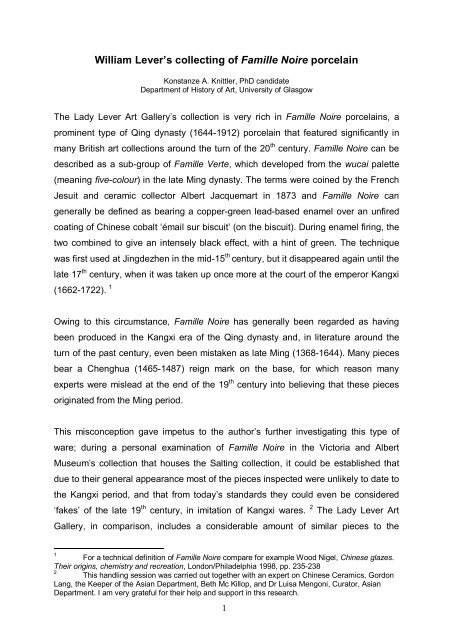
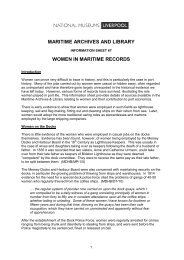
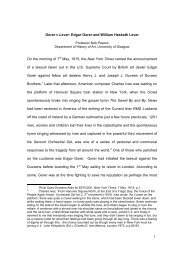
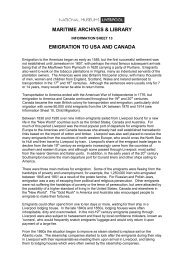
![Ancient Egypt trail [227kb .pdf] - National Museums Liverpool](https://img.yumpu.com/48998817/1/184x260/ancient-egypt-trail-227kb-pdf-national-museums-liverpool.jpg?quality=85)

